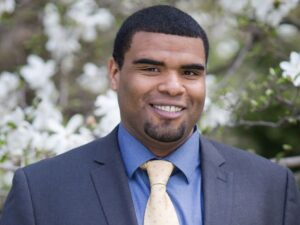Former PhD Students

TaShara Bailey completed her Ph.D. in Higher Education in 2015.
Organizational Support, Satisfaction, and STEM Research Career Plans in Pipeline Interventions: A Strengths-Based Approach among Underrepresented Students.
Dissertation abstract:
This policy-relevant study provides new insight into the social organization of pipeline interventions for underrepresented (UR) students and how strong organizational support can help to explain successful Science, Technology, Engineering, and Mathematics (STEM) outcomes. Guided by the strengths-based role stress and adaptation literature, the study focused on two major Research Aims: (1) to develop reliable and valid measures of strong formal and informal organizational support that are useful for research on UR students in pipeline interventions; and (2) to explore how strong formal and informal organizational support measures may help to explain overall program satisfaction and successful STEM research career plans among UR students. To investigate several related questions, multivariate analyses were conducted on panel survey data from UR students in a strong pipeline program with multiple program components and UR students in other pipeline interventions with fewer formal program components. With respect to the Research Aim 1, factor analyses clearly supported the reliability and validity of both formal and informal organizational support scales. This NIH-NIGMS supported study revealed that UR students in a nationally recognized Summer Research Opportunity Program designed with multiple components had higher scores on the strong formal organizational support scale items. Moreover, UR students with higher formal organizational support also had significantly higher informal support from program peers than from either faculty mentors or program staff sources. Overall, findings on Research Aim 2 were less clear as STEM major emerged as the strongest predictor of STEM research career plans. However, there were: (1) a clear relationship between strong formal organizational support and program satisfaction, and (2) a significant but modest relationship between program satisfaction and STEM research career plans. Racial/ethnic and gender comparisons revealed some interesting directions for future policy-relevant research and practice to broaden participation in STEM research careers. The relevance of study findings was also discussed with an emphasis on refining a strengths-based model of successful STEM outcomes, guiding future research as well as implications for program practice and policy.

Victoria Milazzo Bigelow completed her PhD in 2013
Urban Education Reform: A Qualitative Study of Change in Selected District and Public Charter High Schools
Dissertation abstract:
This dissertation examines how eight urban high schools responded to mandates to raise graduation requirements in mathematics. The change process was complicated by challenges such as the conditions of poverty, lack of adequate financial support for schools, and large numbers of students who come to high school with inadequate preparation in mathematics. Using a qualitative multiple-case study approach, the dissertation examined and compared patterns of change in four public charter schools and four district-accountable high schools. The schools used a range of school reform models such as early college, schools within schools, and schools with curricula linked to career themes. Data was collected from interviews with teachers, administrators in eight schools and with students, adult mentors, and program directors in four schools. Additional information sources included document analysis and observations. The study used a three-level approach to analysis: differences in organizational adaptation in public charter schools compared to district-accountable schools; schools’ adaptation of the mathematics curriculum to meet new requirements; and social support processes that helped motivate students. The comparison reveals that: 1) the charter schools were free from centralized district governance, but school-level adaptivity could be constrained by other management structures exerting top-down control; 2) mandates for college-preparatory standards posed capacity-building challenges for all eight high schools because most of their students were prospective first-generation college students without basic math skills; and 3) the charter schools had greater flexibility to adapt the curriculum locally than the district-accountable schools, but only two of these schools took advantage of this freedom. Although the district-accountable schools were constrained in their ability to adapt the mathematics curriculum locally, they were able to build capacity to provide social support interventions for students through partnerships with a non-profit organization. Student interview data indicated that these interventions motivated them toward higher achievement and college aspirations. Three of the charter schools had also formed partnerships to provide interventions. However, as there were no interviews with students or parents, the evidence supporting positive outcomes was indirect.
John Burkhardt completed their PhD in 2019
Meeting the Need for Emergency Medicine Physicians: A National Study of Factors Influencing Medical Specialty Career Choice
Dissertation Abstract:
Objective: The process by which medical students choose a specialization is incompletely understood, especially as related to factors that influence changes in specific career interest during medical school. Women and Underrepresented in Medicine (URiM) students are less likely than their peer to apply for residency in emergency medicine (EM). Identifying whether medical students from these groups have baseline differences in their career interests or if the lower likelihood in planning a career in certain medical specialties develops during medical school. However, comparison to other major medical specialty patterns will provide the first steps toward a general understanding of the mechanisms at play.
Hypothesis: First, female and URiM students have lower interest in EM even after controlling for other factors. Second, career interest in EM for both groups would be like other students at medical school onset and that a “cooling out” of interest would occur. Third, that women and URiM physicians would exhibit no difference in EM career persistence. Fourth, female and male students enter medical school with similar interest in fields like internal medicine and surgery and women will have higher odds of an interest in fields with typically more female physicians such as pediatrics and OB/GYN. Fifth, URiM students will have equivalent interests not non-URiM students. Sixth, women will both be “cooled out” and under-recruited. Fourth, URiM medical specialty interest will remain relatively stable from entry of medical school to graduation.
Methods: Secondary data analyses was conducted on a cross-section of all residency applicants from 2005-2010. Data sources included: AAMC, NBME, AMA. Binary logistic regression ix models (BLM) were fitted with the outcomes: a planned career in EM at medical school entry, planned career in EM at graduation, and continued practice in EM. BLMs were also fitted with the outcomes: a planned career in one of four medical specialties (Internal Medicine, Pediatrics, OB/GYN, and General Surgery/Surgical Specialties) at medical school entry and again at graduation. Regression models included demographics, student attitudes, debt, undergraduate GPA and standardized test scores, and, medical school experiences.
Results: URiM students expressed less interest in a career in EM when entering medical school and at graduation. No gender differences in interest existed at medical school onset. Women were less likely to enter EM by the time of medical school graduation. After residency, both female and URiM students had similar persistence in EM as all other graduates. Women were less likely to be interested in a career in Internal Medicine and Surgery and more interested in Pediatrics and OB/GYN at the start of medical school while URiM students expressed more interest in OB/GYN and Surgery. At graduation, women were still less likely to enter Internal Medicine and Surgery and more interested in OB/GYN and Surgery. URiM students were more likely to enter in Internal Medicine and less likely Pediatrics.
Conclusions: Female and URiM medical students were less likely to enter EM. Women were less likely to develop a career interest in EM. While URiM students were less interested in EM generally, those initially interested in EM had a “cooling out” effect. Women have stable preferences regarding planned medical specialties in other specialties. In contrast, URiM students enter medical school more likely to enter OB/GYN and Surgical careers but at graduation were more likely to plan on Internal Medicine and less likely Pediatrics.
 Julio Cardona completed his PhD in 2013
Julio Cardona completed his PhD in 2013
Determined to Succeed: Motivation Towards Doctoral Degree Completion
Dissertation Abstract:
High rates of student attrition (upwards to 40-50% in certain academic disciplines) continue to hinder doctoral education. In response to this issue, this study investigated doctoral student motivation by identifying intrinsic and extrinsic factors that affect students’ motivation towards doctoral degree completion. The analytic sample was comprised of 36 doctoral students in four Social Science academic disciplines at one institution. The data were analyzed using a multiple case study method, and the psychological theory of self-determination was utilized to understand the role of motivation in students’ progress towards degree completion. The participants in this study reported various motivational factors relevant to self-determination theory (intrinsic, extrinsic, and autonomous motivation, and psychological need for competence, relatedness, and autonomy). Students explained that intrinsic, extrinsic, and autonomous motivation was important in developing and sustaining their motivation towards degree completion. Students who received support for the needs of autonomy, relatedness, and competency seem to develop motivation to reprioritize their values and articulate their needs and approach personal growth and change with a self-motivated mindset. The study illustrated how students’ personal and academic needs, the academic environment, and career and academic support influenced their motivation to complete the doctoral degree. For some students, their motivation was challenged by the nature of doctoral work, particularly the unstructured process of completing a dissertation. Other students found increasingly difficult challenges in their motivation towards degree completion that included lack of funding, support, and potential employment after graduation. Additionally, students had a variety of positive and negative experiences within their respective doctoral programs that shaped their motivation towards degree completion. Factors that varied across the four disciplines included: academic and personal support, financial factors, student engagement, and doctoral cohort support each of which affected students’ motivation. Implications for practice include recommendations for an infrastructure of departmental and institutional support to assist doctoral students with their academic and personal needs, as well as the development of dissertation support groups utilizing cognitive restructuring and stress management training. Implications for research include a call for studies to examine the complementary, or synergistic, roles of intrinsic motivation for growth and adaptation of doctoral students.

James Ellis completed his PhD in 2015.
College Readiness Beliefs and Behaviors of Adolescents in a Pre-College Access Program: An Extension of the Theory of Planned Behavior
Dissertation Abstract:
Higher education policy-makers, practitioners and researchers increasingly seek to better understand interventions that reduce opportunity gaps faced by minority and low-income students across the PK-20 pipeline. Going beyond evaluation studies, this theory-driven dissertation provides new insight into key connections between social-cognitive motivation, active program participation and successful college readiness behaviors in the GEAR UP intervention. Extending the Theory of Planned Behavior (TPB), these connections are investigated in three studies that focus on self-regulated learning behaviors critical for college preparation and readiness among low-income students. The first study examined the relationship between key TPB student strengths – attitudes, control beliefs, subjective norms and intentions – and GEAR UP participation. The second study investigated the reciprocal relationship between students’ GEAR UP participation and subsequent self-regulated learning attitudes, beliefs, norms and intentions. The third study explored whether systematic barriers (low parental education) moderated the association between TPB motivational strengths and GEAR UP participation. Structural equation analysis of longitudinal (two-wave) panel survey data from a predominantly African American 8th and 9th grade sample provided several key findings. The first study revealed that strong control beliefs motivated active participation in GEAR UP. As hypothesized, behavioral intentions mediated this control belief-active participation relationship. The second study found a surprising inverse relationship between students’ active participation and subsequent attitudes toward self-regulated learning. This unexpected finding suggests that active GEAR UP college readiness activities (rigorous course and test preparations) exacerbate distressful orientations (attitudes) toward competitive self-regulated learning behaviors. The third study revealed that higher expectations of significant others (teachers, counselors, parents) increased active participation in GEAR UP for the lower-SES students but decreased active participation for higher-SES students. Overall, this TPB extension provides a better understanding of how low-income students translate social-cognitive motivational beliefs into self-regulated learning behavioral processes that promote college preparation and readiness. Findings suggest that successful pipeline interventions must pay greater attention to the social-psychological strengths that students bring to program settings, how such strengths effect and are effected by active program participation, and how these reciprocal relationships may differ for low-income students faced with systemic barriers. These findings have important theoretical and practical implications.
Amy Fisher completed their dissertation in 2013
When Did Public Become the New Private? Grappling with Access to Postsecondary Education for Low-Income Students.
Dissertation Abstract:
The shift to a knowledge economy has increased numbers of individuals pursuing postsecondary education. Low-income students do not access this process as high-income students do. Framed within a philosophy of justice, this three-study dissertation examines privatization and how one state increases postsecondary opportunity for low-income students. Fixed effects regression results from the first study (using public databases such as IPEDS, ICPSR, and Census) indicate that poverty rate is positively related to privatization, and per capita tax revenue and liberal ideologies are negatively associated with privatization. Indiana’s Twenty-first Century Scholars program guarantees financial aid and provides support services at regional centers if low-income students maintain a minimum high school GPA and satisfy other Scholar’s pledge components. Using data from the State Student Assistance Commission in Indiana and Student Information Systems on the 2004 high school cohort, two multinomial logits estimate academic preparation outcomes (honors or college preparatory versus a regular diploma) and college choice (four-year or research institutions versus two-year colleges), and a logit predicts college enrollment decisions. Compared to Pell recipients, Scholars whose parents participated in visits/events had higher odds of graduating with honors, and Scholars who visited regional centers increased their odds of completing the college preparation diploma. Logistic regression of all Scholars indicates that student counseling and parent participation in visits/events increase, and parent participation in academic preparation decreases, odds of enrolling. Compared to Pell recipients, the results of the college choice model demonstrate that Scholar participation in counseling decreases the odds of enrolling in four-year and research institutions. Parent participation in academic preparation increases the odds of enrolling in four-year and research institutions when adding academic preparation control variables; parent participation in visits/events and in career planning lose significance with those controls. Thus interventions (typically tax-supported) designed to build social capital increase academic preparation and college participation by low-income students. The three studies reveal a clash among the public and private goals of postsecondary education and equality of opportunity. Consequences of privatization include: reduced access, breakdown of the implied social contract, and increased social stratification. The dissertation concludes with recommendations for policymakers and future research.

Gloryvee Fonseca-Bolorin completed their PhD in 2022.
Strength-based Framework of College Student Persistence: The Relationships between Campus Racial Climate, Racial Ethnic Identity, Sense of Belonging and Intentions to Persist among Black and Latinx Students Attending Predominantly White Institutions
Dissertation Abstract:
In alignment with strengths-based role strain adaptation models (Bowman, 2013), my dissertation investigates how social psychological strengths that Black and Latinx students bring to predominantly White higher education environments influence their perceptions and behavior in college. Strength-based models (SBM) highlight the importance of considering an individual’s strengths in counseling interventions and cross-cultural research (Bowman, 2013; 2006). In contrast to widely used deficit frameworks, this study employs a strengths-based approach to understand Black and Latinx college student experiences by focusing on individual and group level strengths that facilitate student adaptation. Utilizing structural equation modeling, I examine how racial ethnic identity along with perceptions of the campus racial climate relate to students’ sense of belonging and intentions to persist. More specifically, I analyze longitudinal survey data from 588 Black and Latinx students in five predominantly white institutions to investigate the direct and indirect influences of campus racial climate (racial ethnic stigma) and three dimensions of racial ethnic identity (centrality, private regard and public regard) on students’ sense of belonging and intentions to persist one academic year later. In addition, this study examines whether dimensions of racial ethnic identity moderate the influence the campus racial climate (racial ethnic stigma) on sense of belonging and intentions to persist. Findings indicate that sense of belonging operated as a mediator and had a consistent and direct relationship to student’s intentions to persist in college. While contextual dimensions of the campus racial climate were important, interpersonal dimensions had a significant relationship to sense of belonging and intentions to persist. More specifically, perceptions of stigma consciousness was negatively associated with belonging and intentions to persist. Surprisingly, only public regard was related to sense of belonging and intentions to persist in college. Also, there were no moderating relationships found between those with different racial ethnic identity beliefs and attitudes and those with different perceptions of the campus racial climate on sense of belonging and intentions to persist. However, when Black and Latinx student were examined separately, perceptions of the classroom inferiorization and stigma consciousness and different beliefs about centrality, private and public regards were considered, the multiplicative effect exacerbated the negative relationship to belonging and intentions to persist. The strength-based model of college student persistence and related study findings have important implications for theory, research and practice. First, the strength-based conceptual model of college student persistence offers an alternative to the deficit lens used to understand Black and Latinx student experiences. Second, the findings have important implications for future research to further clarify the multiples social psychological dimensions of the campus and racial climate ethnic identity in order to understand how lived experiences influence stigmatized students’ persistence in college. Finally, the findings have policy relevance for informing strengths-based strategies that promote persistence among stigmatized student groups and specifically Black and Latinx students by reinforcing the cultural strengths that they bring to their experiences at predominantly White institutions.
Feven Girmay completed their dissertation in 2017
African Immigrant and International Students: A Qualitative Study on the Socio-Cultural Adjustment of Students Into U.S. Universities
Dissertation Abstract:
Cross-cultural studies on acculturation span across multiple disciplines such as psychology, sociology, and higher education, and seek to explore the cultural adaptation of immigrant and international students. Existing literature informed a guiding conceptual framework for understanding how students adjust to the local culture, and has identified obstacles that hinder the successful navigation of the acculturation process. The present study examined gaps in existing higher education literature on the socio-cultural adjustment process of African immigrant and international students (migrant students). Going beyond past studies, this investigation addressed three questions: What is the role of heritage culture and social class in African migrant students’ preparation for college in the United States (U.S.)? What barriers did African migrant students encounter as they navigate their way through American universities? Guided by a strengths-based perspective, how is heritage culture and access to capital associated with their navigation through and around those barriers in their adjustment process?
To address these three research questions, this qualitative study employed in-depth interviews to examine the socio-cultural adjustment of African immigrant and international students (n=28) enrolled at four-year colleges in the U.S. A grounded theory approach to data analysis revealed how African immigrant and international students’ adjustment to the university environment was associated with both their background and university experiences. In terms of background, students’ socio-economic status and heritage culture were key factors that influenced their preparation for college in the U.S. Furthermore, the study revealed the strengths xii of students’ backgrounds in fostering a sense of community cultural wealth, which helped to facilitate students’ adjustment to their universities. Once African students entered college, they faced socio- cultural and academic barriers associated with: 1) cultural value differences; 2) experiences with racial/ethnic prejudice; and 3) and difficulty with the academic norms and expectations of U.S. universities. Additionally, students discussed access to cultural, academic, and social capital from four primary sources: extensive orientations, racially/culturally similar groups, faculty, and academic support programs/services. These cultural and university-based resources helped to mitigate the negative impact of stressful barriers, and supported students’ socio-cultural adjustment. Going beyond existing cross-cultural literature, findings informed the development of a new strengths-based conceptual model of cultural adjustment and resilience. This model provides a more comprehensive framework to understanding the socio-cultural adaptation process of African migrant and international students in higher education with important implications for multicultural diversity research, practice, and policy.
Elizabeth Hudson completed their dissertation in 2013
Developing and Sustaining Relationships in a Multi-sector Higher Education Access Coalition for Urban Neighborhood Change
Dissertation Abstract:
For more than two decades, higher education institutions have increased efforts to support neighborhood change and problem solving with practices labeled civic or community engagement. Critics and participants question whether an institutional engagement movement exists, and they also critique the efficacy of associated practices, especially because they can privilege institutional outcomes over community need. Despite the challenges, neighborhood partners may find value in higher education partnership’s potential to develop social capital. In some cases, higher education engagement has become embedded in neighborhood change efforts, but engagement research rarely analyzes the complexities of relationship development processes in coalitions. Guided by constructs from social capital theory, this study analyzes one multi -sector, urban, educational opportunity coalition to understand how relationships among higher education and neighborhood partners generated resources and structured resource allocation. The coalition, called the Sunnydale Jobs and Education Network (SJEN), included representatives from community – based organizations, higher education institutions, private foundations, a charter school, and faith -based organizations. SJEN partners collaborated for six years beginning in 2006. This analysis focuses on the initial four years of problem defining and finding external resources. I employ archival and participatory observation x methods on secondary data sources, such as interviews, meeting notes, and grant applications. The findings from this analysis inform higher education community engagement for coalition -based change and educational opportunity by drawing attention to the structure of resource development in coalition partnership. In SJEN, four tensions emerged to undermine equitable distribution of resources: a vague concept of community, institutional obligations, transience, and funding structures. These tensions manifested to privilege school and higher education institutional outcomes, alienating some partners and limiting engagement with residents. However, the coalition eventually built trust that enabled productive conversations where marginalized partners could air their frustrations about inequitable resource distribution. Based on this insight, I construct an alternative model for higher education coalitions with potentially useful considerations for partners. This model emphasizes trust building and balancing bridging and bonding capital to embrace both institutional and relational approaches to change. Higher education engagement can benefit from deliberate partner involvement and deliberative communication among partners to establish mutuality, a measure of quality engagement.
Maria Johnson completed their dissertation in 2010
Through A Daughter’s Eyes: Understanding the Influence of Black Fathers on Their Daughters’ Conceptualizations of Fatherhood and Womanhood
Dissertation Abstract:
Based on 79 qualitative, in-depth interviews of 40 African-American college-educated women between the ages of 18 and 22, this dissertation compares how women from two-parent households and single-mother-headed households construct narratives of their experiences with their fathers. The dissertation accomplishes three objectives: 1) to highlight the means by which Black women actively work to deconstruct and navigate dominant images of fatherhood and Black fatherhood; 2) to discuss the contribution of Black fathers to the daughters’ sense of womanhood (as theorized by respondents); and 3) to link the findings with federal policy initiatives regarding fatherhood.
I find that the women neither fully embraced nor rejected traditional paternal roles, such as the breadwinners and head of household. Instead, they made sense of dominant discourse by incorporating their actual experiences with their fathers into their ideal narratives regarding fatherhood, particularly Black fatherhood. I also find that social fathers are significant to the women’s conceptualizations of fatherhood, as many provide alternative images of male contributions to family life.
The women in my study employ fathers in their narratives of Black femininity. They argue that their fathers contributed to their abilities as African Americans and women to navigate public spaces and intimate relationships. I also find that the women in my study express great agency as they contemplated their daughter-father relationships. Women with disconnected relationships with their fathers use their perspectives on forgiveness and reconciliation to afford themselves power and control within their daughter-father relationships.
Overall, the women’s reflections on mainstream and alternative forms of fathering and daughter-father relationships have important implications for social policies related to Responsible Fatherhood. 1 argue that Responsible Fatherhood policies should be child-focused and reflect the realities of daughter-father relationships.
 Omari Keeles completed his dissertation in 2020
Omari Keeles completed his dissertation in 2020
Class Matters: Social Class Identity Profiles of Black Students and Implications for Psychological Adjustment to Predominantly White Institutions
Dissertation Abstract:
Scholarly discourse and empirical analyses of social class impacts in higher education tend to conflate race and social class, suggesting that Black students’ outcomes can be largely explained by their higher proportions of economic and social disadvantage. This result of studies that do not consider the variation within class groups by race is the framing of Black students – explicitly or implicitly – as a monolithic group with common identities, preferences, experiences, and adjustment to higher education contexts. Drawing from social identity frameworks (i.e,, Social Identity Theory, Tajfel & Turner, 1986; and the Multidimensional Framework of Social Class Identity, Webb, 2014), the current dissertation explores how social class identity processes help explain individual variation in Black college students’ psychological adjustment to predominantly White institutions. Using data from the College Academic and Social Identities Study (CASIS) I examined a sample of Black college students (n=375) over their first year of college and 1) identified latent profiles based on patterns of Black college students’ social class centrality and social class affect (pride, shame, and guilt) upon matriculating into college (Time 1). I also investigated if individuals’ social class selfidentification was associated with membership in particular social class centrality and affect (pride, shame, guilt) profile groups in PWI contexts; 2) I examined how Black college students’ social class centrality and affect profiles were related to their Time 1 and Time 2 psychological adjustment outcomes; and 3) analyzed whether Black college students’ social class centrality and affect profiles moderated the associations between social class self-identification and psychological adjustment outcomes. Key findings show that Black college students vary in the extent to which they make meaning of the importance and emotions attached to their social class identity. There were significant differences by profile group in psychological adjustment outcomes. Profiles that xiii included students who reported high levels of negative affect (shame and guilt) reported lower levels of adaptive psychological adjustment. Social class centrality and affect profile that included students who reported high levels of social class pride reported more adaptive psychological adjustment to the PWI context. However, the relation between social class self-identification and psychological adjustment did not vary as a function of social class centrality and affect profile group.

Kim Lijana completed her PhD in 2015
Understanding the College Application and Decision-making Process in Context: African American Students and their Families
Dissertation Abstract:
This study explores the postsecondary decision-making processes for African American seniors in an urban public high school in Michigan. While there is considerable research on college choice processes, few qualitative studies have examined college application behavior in urban high schools that serve predominately low-income African American students. The main research question that guides this study is: How do high school seniors and their families engage in postsecondary planning and select a postsecondary pathway in an under-resourced school committed to college access? Using a case study design, the author closely followed twelve students (6 male and 6 female) in a class of 100 and the families of eight of the 12 throughout their senior year at an urban high school dedicated to encouraging all students to pursue postsecondary education. Students selected for the study were all academically eligible to attend some four-year colleges. A major finding was that students and families relied on trusted information sources when determining where to apply and enroll. Moreover, guaranteed financial-aid also influenced students to attend specific eligible institutions because they believe the funds were reliable. Where students applied and decided to attend college was shaped by higher education marketing and recruitment: college representative visits, on-site admissions decisions, college visits, and flyers by mail. Peers played a critical role in sharing information about specific institutions and providing encouragement, which influenced both where students applied and decided to attend. Overall, findings suggest that low-income urban high schools can create opportunity for African American students by developing a strong “application culture” and collaborating with colleges. Nevertheless, an application culture does not necessarily mean high-achieving students will attend institutions that are best suited to their academic goals or that all students will enroll. African American students and their families tend to perceive college to be the pathway to a career that can provide financial stability and happiness. However, interventions that promote their college-going may have unintended consequences, including dampening four-year college aspirations and redirecting many to two-year institutions. Intervention strategies that provide more opportunities for students’ families and peers to learn about college options could further promote college access.

Christopher James Nellum completed is PhD in 2014
A Multi-Institutional Study of Black and Latina/o Community College Students’ Transfer Intentions: A Theory of Planned Behavior Reconceptualization.
Dissertation Abstract:
Community colleges currently enroll over one-third of all undergraduates and serve as the gateway to postsecondary education for increasing numbers of Americans in the 21st century, especially students of color. A significant portion of community college students aspire to transfer to a four-year college or university, but only 23% to 40% make this transition within six years of initial enrollment with disturbing racial/ethnic disparities. Existing studies offer sociological explanations for the persistent disparity in upward transfer rates between White community college students and lower rates for African American and Latino community college students. The present theory-driven study aims to better explicate the social psychological factors that motivate community college students interested in upward transfer. This study seeks to better understand whether the constructs central to the Theory of Planned Behavior (TPB) explain variation in African American and Latino students’ intentions to transfer from a community college to a four-year college or university. Structural equation modeling was used with a sample of 154 African American and 831 Latino community college students enrolled at 6 institutions across the United States to test and extend the theory of planned behavior. Additional questions assessed whether policy-relevant collegiate experiences moderate intentions to transfer. Study findings support the importance of racial/ethnic-specific patterns, with clear distinctions between TPB predictors of transfer intentions for African American and Latino students. For the Latino students, significant attitudes reflected underlying beliefs about the instrumentality of transfer; subjective norms reflected expectations of non-academic; and academic individuals; and control considerations included lack of academic capacity and financial constraints. The results also show that students who participated in developmental education courses or had a positive perception of transfer climate report differences in intentions to transfer. Future research should go beyond TPB concepts to better understand social psychological mechanisms that motivate transfer intentions for African American community college students. The theory-driven findings on Latino community college students have important policy-relevant implications for targeted interventions to improve and support intentions to transfer and for future research on upward transfer.

Gordon Palmer completed his PhD in 2021
Making a place for justice: Spirituality and place-making in the sociopolitical development of Black emerging adult women
Dissertation Abstract:
Emerging adulthood (ages 18-29) is a developmental period in which individuals explore their identities, achieve status markers (e.g., marriage), and become able to participate more fully in democracy (Arnett, 2000). There has been substantial exploration of emerging adulthood broadly, but relatively little attention has been paid to emerging adult aged Black women and the ways they navigate the world, their identities, and their sociopolitical development. This dissertation investigated the role of social identities (e.g., race and gender), cultural ideologies (i.e., religiosity/spirituality), and spatial context (i.e., cities and urban higher education institutions) in the SPD of Black emerging adult women (BEAW). Across three studies, I used conceptual frames linking SPD, urban place, religiosity/spirituality (SET- RS Urban; Mattis et al., 2019), Black placemaking, and Black feminist geography (Hunter et al., 2016; McKittrick, 2006) to address three intersecting questions. Study 1 used survey data to address the question: To what extent are religiosity/spirituality and urban place associated with SPD (measured by critical reflection, critical agency, and critical action) among BEAW? In Study 2, I used a qualitative approach and asked: How, if at all, does the religiosity/spirituality of BEAW influence their sociopolitical development? In Study 3, I used a qualitative approach informed by Black feminist epistemology to address the question: How do the ways that BEAW “make place” (i.e., experience, perceive, and imagine urban places—especially urban universities) inform their sociopolitical development? Taken as a whole, these three studies produced new understandings of the ways that urban places and identity engender sociopolitical reflection, efficacy, and action among BEAW. First, Study 1 demonstrated that the various manifestations of religiosity and spirituality are associated with different domains of SPD among BEAW. These findings offered a call to researchers to 1) more thoroughly investigate the dimensions of religiosity and spirituality through communally based measures, and 2) investigate broader denominational, ideological, and regional differences in the socialization of BEAW and how these relate to SPD. Study 2 highlighted that BEAW used religiosity/spirituality as a source of efficacy and motivation as they pursued social justice. Participants placed their actions in a larger and narrative of Divinely-guided justice. This enabled them to undertake the work of justice as a moral good and a as an effort tied to divine purpose. Finally, participants saw themselves as a part of a spiritual sisterhood which allowed them to collectively reflect and engage in critical actions. In Study 3, participant narratives highlight that BEAW critically reflect on and navigate spatial manifestations of oppression in their cities and campuses while at the same time endeavoring to ameliorate these ills through Black placemaking. Further, BEAW not only resist oppressions in these places. They actively cultivate joy and celebrate their everyday existence as Black women.
Michele Randolph received her Ph.D. in Higher Education in 2019
Socio-Cognitive Motivation Predictors and STEM Persistence Plans Among Women of Color: A Social Cognitive Career Theory Reformulation and Investigation
Dissertation abstract:
This study reformulates social cognitive career theory by going beyond the conventional emphasis on self-efficacy to provide new insight into the multiple socio-cognitive motivation predictors of STEM persistence plans among Women of Color (African American and Latina). Building on expectancy-value and role-strain theories, a reformulated socio-cognitive career model (RSCCM) was developed to better understand pivotal motivational factors that empower some Women of Color, despite facing systemic barriers, to persist in their undergraduate STEM majors, pursue Ph.D. degrees and plan STEM research careers. This theory-driven study makes unique contributions to existing higher education literature on college persistence by further clarifying multiple socio-cognitive motivation predictors of STEM persistence plans among Women of Color during the undergraduate-to-graduate studies transition. Based on a larger NIH-NIGMS funded study, multiple regression analyses were conducted on panel survey data from 179 Women of Color who applied to the Summer Research Opportunity Program (SROP) at 14 major universities affiliated with the Big Ten Academic Alliance (BTAA). Guided by the RSCCM, several hypotheses were tested to explore the role of STEM self-efficacy, STEM outcome expectancies, perceived STEM talents, STEM intervention-based appraisals, and perceived barriers and supports on STEM persistence plans. Findings indicate that in addition to self-efficacy, path-goal outcome expectations, strong faculty mentoring and perceived STEM talents were significant predictors of higher STEM persistence plans. Surprisingly, perceived discrimination was associated with higher rather than lower STEM persistence plans, and also moderated the relationship between self-efficacy and STEM persistence plans. The RSCCM and related study findings have important implications for theory, research and practice. First, RSCCM findings have theoretical significance for better understanding the multiple sources of motivation in STEM persistence decisions among Women of Color, especially during advanced stages of career development. Second, findings have important implications for future research to further clarify RSCCM propositions on larger and more diverse samples. Finally, RSCCM findings have policy relevance for informing strengths-based strategies that promote STEM persistence among Women of Color by reinforcing the multiple socio-cognitive motivational strengths that they bring to the BTAA-SROP and other pipeline intervention settings.

Kelly Slay completed her PhD in 2017
Choosing Colleges in a Post-Affirmative Action Era: Black Students’ Perceptions of Institutional Diversity and Campus Climate
Dissertation Abstract:
Highly selective public institutions affected by affirmative action bans have struggled to enroll Black students despite myriad attempts at alternative strategies. Bans likely shift university recruitment practices and shape both campus climate and portrayals of institutional commitment to diversity. Increasingly public racial incidents on college campuses suggest the possibility that Black students’ underrepresentation in selective post-affirmative action contexts may also be a function of choice—Black students’ decision to opt out of institutions they do not perceive to be diverse or inclusive. I conducted an in-depth case study focusing on practices used to encourage Black student enrollment as well as Black students’ appraisals of institutional commitment to diversity and racial climate—both underexplored—as a way to understand the enrollment decisions of Black students admitted to the University of Michigan, a battleground for affirmative action. Guided by an interdisciplinary framework that incorporates models of college choice and social identity theories, including social identity threat and racial identity and concentrating on the yield stage of the admissions cycle, I interviewed 35 Black students (15 enrolled at U-M; 20 enrolled elsewhere) and 16 university professionals across four departments engaged in yield recruitment. I also observed 23 hours of yield events. From the institutional perspective, I found that enrollment professionals were engaged in impression management—efforts to shape admitted Black students’ positive impressions of the university, particularly with respect to diversity and climate. Targeted yield recruitment events and activities were one set of tactics to manage Black students’ impressions. The discourse used in those events represented another set of tactics. Perhaps signaling compliance with the state’s affirmative action ban and awareness of the hostile climate for race-conscious policy, “diversity” was referred to broadly and communicated differently depending on the racial/ethnic identity of the enrollment professional as well as the demographic make-up of the student audience. My findings from the student perspective highlight how Black students’ perceptions of key race and diversity cues from the campus context they encountered during their recruitment experiences were significant in shaping their appraisals of the University of Michigan. The majority of participants expressed concern about the small size of the Black undergraduate population and perceived some level of potential threat (e.g., discrimination and racism) associated with their racial identity. However, among the 20 non-enrollees, only in a few instances were their impressions about diversity or racial climate the deciding factor in their decision to decline admission from the University of Michigan. Among the sample of enrollees, a large portion acknowledged their apprehensions about student racial diversity but still opted to enroll, citing their intention to leverage Black student organizations and cultivate community with same-race peers in order to mitigate potential threats and successfully navigate the stressful campus environment as a Black student. Findings have theoretical implications for understanding the complex interplay between racial identity and consciousness of institutional barriers in college choice. Findings also have implications for enrollment management practices and efforts to increase the representation of Black students in selective, post-affirmative action contexts and in predominantly white institutions, broadly. By highlighting the recruitment activities undertaken to yield Black students and the individual perspectives of Black admitted students, the study also contributes to a small body of literature on recruitment in higher education and deepens our understanding of contemporary sociopolitical issues affecting Black students’ college choice.
Chauncey Smith completed their dissertation in 2017.
Defensive Strategies & Counternarratives: Middle Class Black Boys’ Critical Social Analysis of Their School Experiences
Dissertation Abstract:
Whether persistent or apathetic, academically struggling or high achieving, living in urban or sparsely populated contexts, Black boys are still disproportionately affected by academic, social, and political challenges in their school experiences. Among the many challenges they may face, Black boys are at a high risk of experiencing racial discrimination from adults and peers at school. In light of this risk—after decades of scholarship on Black boys in school—scholars encourage the increased inclusion of Black boys’ meaning making of their school experiences in the literature and they emphasize the potential importance of Black boys’ critical social analysis (the awareness and rejection of oppression) in the school context. In this dissertation, I employ a sociopolitical development framework to explore seven Black adolescent boys’ meaning making and critical social analysis of their experiences at Lakeside, a high school in an affluent suburban community. I co-facilitated a youth participatory action research program aimed at promoting critical social analysis through group discussion and photovoice; the participants completed photovoice projects aimed at highlighting problems they saw at Lakeside. Finally, I conducted semi-structured interviews with each participant; these interviews were aimed at capturing their meaning making and critical social analysis of their experiences at Lakeside. Generally, the boys viewed school as a normal and/or boring space; they recognized the privilege of attending Lakeside—a well-resourced public school with a strong reputation in their region. Regarding their meaning making of being Black boys at Lakeside, the boys reported a trend where mostly boys of color received disciplinary action; additionally, each of the boys xv reported experiencing overt and public racial discrimination from teachers or peers. In response to their negative experiences in school, the boys reported coping by: (1) de-emphasizing the role of race and racism in their problems at school, (2) emphasizing the importance of their personal responsibility in improving their situations as Black boys at Lakeside, and (3) withdrawing emotionally from school. For their photovoice projects, the participants chose to highlight problems of segregation in school spaces and lack of engagement at Lakeside. They initially employed a deficit-based narrative in the description of these problems—asserting that the problems primarily affected and were the fault of Black students. After group discussion and completion of photovoice projects, the boys countered their own deficit-based narratives about Black student achievement and presented suggestions for improved engagement in Lakeside classrooms. The boys in this study engaged in a complicated critical social analysis of their experiences at Lakeside; they recognized the existence of systemic oppression in the world, but denied its manifestation in their experiences of racial discrimination at school. Instead, they often opted to hold only themselves accountable for their negative experiences at Lakeside. Taken together, through discussion and photography, this study expands our understanding of Black boys’ school experiences and the development of their critical social analysis in school and program contexts.
Travis Tatum completed their PhD in 2009
Directed attention and stereotype threat in interracial interactions
Dissertation Abstract:
This research combines stereotype threat theory and attention restoration theory in an attempt to develop an intervention for stereotype threat. Applying stereotype threat to interracial communication provides a framework for understanding how Whites may have a more difficult time communicating about a race-related topic than another topic. Attention restoration theory contributes a potential intervention through the possibility of increasing cognitive resources available to threatened individuals in both a traditional stereotype threat paradigm and in an interracial communication paradigm. Study 1 tested the hypothesis that Whites may experience stereotype threat in interracial communication when discussing a race-related topic, and that this stereotype threat diminishes both speaking ability and recall of a partner’s statement. Results supported this hypothesis, with participants exhibiting a higher rate of speech disfluencies and recalling fewer details of the partner’s statements when the topic was race-related. Study 2 tested the hypothesis that restoring capacity for directed attention improves performance for women taking a math test under stereotype threat. Results did not support this hypothesis; the intervention did not improve participants’ performance under stereotype threat, although it did have a positive impact on performance for those who were not under stereotype threat and for whom math performance was important. Lastly, Study 3 tested the hypothesis that increasing capacity for directed attention improves communication for Whites discussing a race-related topic. Results did not support this hypothesis, as the ix directed attention manipulation did not appear to have any effect on communication performance. The topic manipulation replicated the recall effects demonstrated in Study 1 but not the speech disfluency effects. The role of regulatory strategies in determining the effectiveness of manipulating directed attention is also discussed.

Krystal Williams completed her Ph.D. in Higher Education in 2014
Financial Impediments, Academic Challenges and Pipeline Intervention Efficacy: A Role Strain and Adaptation Approach to Successful STEM Outcomes for Underrepresented Students.
Dissertation abstract:
A growing number of studies highlight how exemplary pipeline interventions can promote college and career success in science, technology, engineering, and mathematics (STEM). However, it is also important to understand how the challenges and strengths that underrepresented students bring to intervention settings can influence their successful STEM outcomes. Guided by role strain and adaptation theory, this study seeks to better explain how intervention participation combines with other pivotal factors to influence students’ plans to pursue research careers in STEM fields. This theory-driven study makes unique contributions to the higher education pipeline intervention literature by further clarifying social psychological mechanisms through which financial and academic challenges impede successful STEM outcomes among underrepresented students within intervention settings. Analyses of longitudinal survey data from 376 underrepresented students who applied to an exemplary Summer Research Opportunity Program at 12 major research universities in the Midwest provided support for several hypotheses. Multivariate analyses found that STEM research career plans appear to be enhanced by intervention participation, but impeded by financial and academic challenges (both objective barriers and subjective threats). Study findings also suggest that personal resiliency, a measure of adaptive cultural strength, can also promote successful STEM outcomes. Study findings support the importance of students’ role strains and strengths in better understanding STEM-related intervention outcomes for underrepresented students. The theory-driven findings can help program administrators and policy-makers better determine not only if, but how, higher education pipeline interventions promote successful STEM outcomes for underserved groups.